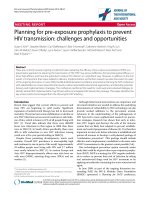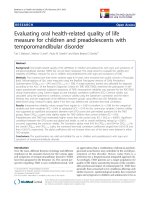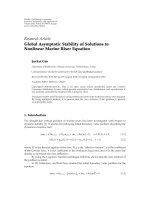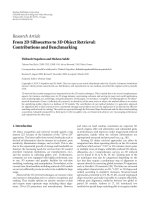Báo cáo hóa học: " ZnO Nanorods via Spray Deposition of Solutions Containing Zinc Chloride and Thiocarbamide" potx
Bạn đang xem bản rút gọn của tài liệu. Xem và tải ngay bản đầy đủ của tài liệu tại đây (536.2 KB, 6 trang )
NANO EXPRESS
ZnO Nanorods via Spray Deposition of Solutions Containing Zinc
Chloride and Thiocarbamide
Tatjana Dedova Æ Olga Volobujeva Æ Jelena Klauson Æ
Arvo Mere Æ Malle Krunks
Received: 16 May 2007 / Accepted: 12 June 2007 / Published online: 19 July 2007
Ó to the authors 2007
Abstract In this work we present the results on formation
of ZnO nanorods prepared by spray of aqueous solutions
containing ZnCl
2
and thiocarbamide (tu) at different molar
ratios. It has been observed that addition of thiocarbamide
into the spray solution has great impact on the size, shape
and phase composition of the ZnO crystals. Obtained layers
were characterized by scanning electron microscopy
(SEM) equipped with energy selected backscattered elec-
tron detection system (ESB), X-ray diffraction (XRD) and
photoluminescence spectroscopy (PL). Small addition of
thiocarbamide into ZnCl
2
solution (ZnCl
2
:tu = 1:0.25)
supports development of significantly thinner ZnO nano-
rods with higher aspect ratio compared to those obtained
from ZnCl
2
solution. Diameter of ZnO rods decreases from
270 to 100 nm and aspect ratio increases from ~2.5 to 12
spraying ZnCl
2
and ZnCl
2
:tu solutions, respectively.
According to XRD, well crystallized (002) orientated pure
wurtzite ZnO crystals have been formed. However, tiny
‘spot’—like formations of ZnS were detected on the side
planes of hexagonal rods prepared from the thiocarbamide
containing solutions. Being adsorbed on the side facets of
the crystals ZnS inhibits width growth and promotes lon-
gitudinal c-axis growth.
Keywords ZnO nanorods Á Spray pyrolysis Á
Thiocarbamide Á Zinc chloride Á Growth mechanism Á
SEM Á PL
Introduction
One-dimensional zinc oxide (ZnO) nanostructures have
been the subject of intense research in the past few years
due to their unique properties and thus potential wide-
ranging applications in a variety of fields such as solar cells
[1–3], sensors [4, 5], short-wavelength light emitting and
field effect devices [6, 7], Schottky diodes [8, 9], and
coating materials [10, 11]. Controlling the size and shape
of nanocrystalline materials is a crucial issue in nano-
science research. The ordered growth and high surface area
of one-dimensional ZnO nanorods are desirable as it would
provide significant enhancement of the devices efficient
functioning.
Several techniques have been developed for the fabri-
cation of the 1D nanostructures, including metal organic
chemical vapor [12, 13], pulsed laser [14, 15], electro-
chemical deposition techniques [16, 17], vapor–liquid–so-
lid [18, 19] and wet chemical methods [20–22].
Chemical spray pyrolysis has the advantage over the
other methods being a less time and expenses consumable,
catalyst and template free method to prepare ZnO nano-
structures.
In our previous works [23–25] we have demonstrated
the possibility to synthesize high quality c-axis orientated
ZnO rods by a simple spray pyrolysis deposition method
using zinc chloride aqueous solutions as a single precursor.
It was found that size, shape and aspect ratio of ZnO
nanostructures prepared by spray pyrolysis strongly depend
on the ZnCl
2
concentration, deposition time, growth tem-
perature and the substrate properties. In solution systems of
wet-growth methods, the morphology of grown ZnO
crystals has been controlled by the reaction conditions and
the presence of various additives. In order to obtain the
desired crystals size, shape and aspect ratios of final ZnO
T. Dedova (&) Á O. Volobujeva Á J. Klauson Á
A. Mere Á M. Krunks
Department of Materials Science, Tallinn University of
Technology, Ehitajate tee 5, Tallinn 19086, Estonia
e-mail:
123
Nanoscale Res Lett (2007) 2:391–396
DOI 10.1007/s11671-007-9072-6
product by solution-based methods, so-called surfactant or
capping molecules are added to the solution. They can
manipulate the growth kinetics and determine the final
morphologies being adsorbed to the certain crystal planes.
For instance, hexamine [26] and oleic acid [27] inhibit
[0110] and promotes the [0001] growth resulting in thinner
and high-aspect ratio rods. Additives such as sodium
dodecyl sulfate (SDS) [28], triethanolamine (TEA) [28],
citric acid [29] retard the growth along the c-axis direction
resulting in a disk-like structures or platy forms.
In this study, we demonstrate the influence of thiocar-
bamide addition to the zinc chloride solution on develop-
ment of ZnO rods, their dimensions, phase composition,
morphological, structural and photoluminescence (PL)
properties. The formation chemistry and growth mecha-
nism of the ZnO nanorods is proposed. To our best
knowledge this is the first report on preparation of ZnO
nanorods from thiourea and zinc chloride solution system.
Experimental
ZnO nanorods were deposited using pneumatic spray
pyrolysis technique. Spray aqueous solution was prepared
by mixing of ZnCl
2
and thiocarbamide (tu) at the molar
ratios (Zn:tu) of 1:0 (ZnCl
2
solution without tu), 1:0.05,
1:0.1, 1:0.25 and 1:0.5. The ZnCl
2
concentration in solu-
tions was adjusted to 0.1 and 0.05 mol/L. The resultant
solution in amount of 50 mL was pulverized onto the SnO
2
covered glass and soda-lime bare glass substrates mounted
on a soldered tin bath.
The deposition temperature (T
S
, temperature at substrate
surface) was kept at 520 °C and controlled through the tin
bath temperature using an electronic temperature controller.
The solution flow rate and gas pressure were kept constant at
2.5 mL/min and 8 L/min, respectively; air was used as the
carrier gas supplied by filter equipped oil-free compressor.
The structural characterization of deposited films struc-
tures was carried out on Bruker AXS D5005 diffractometer
(monochromatic Cu Ka radiation, k = 1.54056 A
˚
)in2h
range 20–60 deg with the step of 0.04 deg and counting time
2 s/step. The reflections were identified by JCPDS files.
The surface morphology and film cross-section micro-
graphs were taken by a high-resolution scanning electron
microscope ZEISS Ultra 55 equipped with an Energy
Backscattered electron (ESB) detector to determine the
elemental composition difference. For the room-tempera-
ture photoluminescence measurements, a He–Cd laser with
a wavelength of 325 nm was used for excitation. The PL
spectra were taken with a SPM-2 grating monocromator
(f = 0.4 m) and the signal was detected with a photomul-
tiplier tube. The measurements were made in the 310–
620 nm range.
Results and Discussion
Effect of Thiocarbamide on Morphology of ZnO
Nanorods
Figure 1 illustrates the SEM images of ZnO nanorods
deposited onto SnO
2
covered glass substrates by the spray
pyrolysis process using zinc chloride (Fig. 1a) and zinc
chloride containing thiocarbamide additive adjusting the
molar ratio of Zn:tu = 1:0.25 (Fig. 1b). Zinc chloride
concentration in solution of 0.05 mol/L and deposition
temperature of 520 °C were kept constant for both samples.
As can be seen, thiocarbamide additive drastically influ-
ences the ZnO nanorods dimensions. The diameters of rods
decreased from 300 to 120 nm, and length increased from
500 to 700 nm, resulting in increase of the aspect ratio
more than three times for the samples deposited from
thiourea containing solution.
In our previous work [25] we have observed that in
order to grow well-aligned ZnO nanorods on SnO
2
,itis
essential to use the precursor concentration in solutions
below than 0.1 mol/L. Since the deposition of 0.1 mol/L
solutions resulted in fat ZnO crystals with low aspect ratio.
Strikingly, elongated high aspect ratio (~12) ZnO
nanorods has been observed using thiourea (Zn:tu =
1:0.25, molar ratios) in the ZnCl
2
solution with concen-
tration of 0.1 mol/L (See Fig. 2).
The comparison of average diameters, lengths and as-
pect ratios of the sprayed ZnO nanocrystals depending on
Fig. 1 SEM micrographs from
the surface and cross-sectional
views (in inset) of ZnO samples
deposited using ZnCl
2
solutions:
(a) without and (b) containing
thiourea at Zn:tu molar ratio of
1:0.25; [Zn
2+
] = 0.05 mol/L
392 Nanoscale Res Lett (2007) 2:391–396
123
the ZnCl
2
concentration and content of thiourea additive
are summarized in Table 1.
As it could be seen from Table 1, thiocarbamide addi-
tion generally leads to the formation of thinner rods with
higher aspect ratio compared to those deposited from
ZnCl
2
solution. However, amount of thiocarbamide in
solution is extremely important factor which determines
the final rods dimensions. For instance, too low (Zn:tu =
1:0.05) or too high (Zn:tu = 1:0.5) amount of added
thiourea results in thicker and low aspect ratio rods. The
molar ratio of Zn:tu = 1:0.25 seems to be optimal in order
to grow highest aspect ratio nanorods.
Structural Properties and Phase Composition of ZnO
Layers
Figure 3 shows the XRD pattern of the sprayed nanorods
prepared from solution containing thiocarbamide with
Zn:tu ratio = 1:0.25 and [Zn
2+
] = 0.1 mol/L. Strong and
sharp diffraction peak at 2h = 34.4° corresponds to the
(002) reflection of ZnO wurtzite phase (JCPDS 36-1451)
indicating preferred orientation in the c-axis direction. No
other peaks related to any impurity phases were observed
in this XRD graph.
However some ‘‘spots’’ like contaminations on the
planes of well-formed hexagonal crystals could be ob-
served in high magnification SEM micrograph (Fig. 4b).
The colour contrast difference on ESB analysis (Fig. 4a)
clearly indicates that the elemental composition of ‘spots’
differ from the ZnO rods. As the formation of spots on ZnO
lateral facets has been found only in the case of thiourea
containing spray solutions, obviously the origin of spots is
issued from the thiourea. Here should be pointed out that
the upper planes of the crystals are clean from the con-
taminants having very smooth well-developed hexagon.
From earlier reports [30–32] it is known that ZnCl
2
and
thiourea are main precursors for ZnS thin films deposition
by spray pyrolysis. To control whether the ‘‘spots’’ belong
Fig. 2 The SEM surface and cross-sectional views (inset) images of
ZnO nanorods obtained from solution with thiourea addition at molar
ratio of Zn:tu = 1:0.25, [Zn
2+
] = 0.1 mol/L
Table 1 The average diameters, lengths and aspect ratios of the
sprayed ZnO nanorods deposited from solutions without and with
thiourea at two different concentrations of ZnCl
2
—0.05 mol/L and
0.1 mol/L
[Zn
2+
] Zn:tu Length (L) Diameter (D) Aspect ratio (L/D)
C = 0.05 1:0 500 300 1.7
1:0.25 700 120 6
C = 0.1 1:0 700 270 2.5
1:0.05 750 250 3
1:0.1 800 200 4
1:0.25 1,200 100 12
1:0.5 700 250 3
Fig. 4 (a) ESB and (b) high magnification SEM cross-sectional
micrographs of the sample deposited from solutions containing ZnCl
2
and thiocarbamide (Zn:tu = 1:0.25), [Zn
2+
] = 0.1 mol/L
25 30 35 40 45 50 55 60
OnS
2
)101( OnZ
OnS
2
)01
1(
On
Z
OnS
2
)001( OnZ
)200(
OnZ
.u.a ,ytisnetnI
2 θ, deg.
Fig. 3 XRD pattern of the samples deposited from solutions
containing ZnCl
2
and thiocarbamide (Zn:tu = 1:0.25), [Zn
2+
] = 0.1
mol/L
Nanoscale Res Lett (2007) 2:391–396 393
123
to ZnS phase we prepared the ZnO samples increasing the
content of tu in solution (molar ratio of Zn:tu = 1:0.5).
According to SEM (not presented here) amount of spots on
the crystal side planes has increased and well developed
but thicker ZnO rods have been formed (see Table 1).
Figure 5 presents the XRD pattern of this sample recorded
using parallel beams.
Weak reflection at 2h of 28.5°, detected in the XRD
pattern, could be attributed to the (111) reflection of ZnS
sphalerite phase. As it has been reported [33, 34], the ZnCl
2
and thiourea in an aqueous solution yield the complex
compound—dichlorobis(thiourea)zinc with molecular for-
mula Zn(tu)
2
Cl
2,
which decomposes with formation of zinc
sulfide at temperatures above 300 °C[33, 34].
Development of ZnO Nanorods in Initial Stages of
Growth: Growth Mechanism
To understand the growth mechanism of ZnO nanorods
obtained with and without thiocarbamide addition into
solution, their morphologies in the initial growth stages
were recorded by SEM.
After 1 min reaction time, ZnO crystals with diameter of
~50 nm from ZnCl
2
solution (Fig. 6a) and ~70 nm from
thiourea containing solution have been formed. The length
and coverage of rods deposited using thiocarbamide addi-
tive is almost two times higher revealing the higher growth
rate. Figure 6c and d shows the SEM images of the samples
obtained when the reaction proceeded 5 min. Figure 6c
clearly reveals that the diameters of the rods grown from
ZnCl
2
has drastically increased (~150 nm) whereas length
is only 200 nm. It also should be pointed out that two
different types of ZnO crystals could be observed in this
picture. Some of them are flat hexagonal prisms; others
have pyramidal-like forms. It is known from the literature
that pyramidal planes are characteristic for moderate
crystal growth being much lower than 002 direction growth
[35]. At the final stage of the growth after 15 min, the
coverage density has increased (Fig. 6e, f) for both types of
solutions. Fat hexagonal prisms with pyramid crystals and
elongated nanorods were obtained from the solutions
containing ZnCl
2
(Fig. 6e) and ZnCl
2
with addition of
thiocarbamide (Fig. 6f), respectively.
On the basis of the SEM and XRD results described
above we propose the following mechanism (illustrated in
Fig. 7) for the formation of ZnO nanorods in the presence
of thiourea in the spray solutions.
It is known that in some crystallization processes the
growth rate of a crystal facet can be inhibited by the
addition of an impurity strongly adsorbing onto the growth
front and thereby ‘poisons’ the incorporation of new mol-
ecules into that facet [36].
The ZnS particles, issued from the zinc–thiocarbamide
complex decomposition being adsorbed onto the freshly
formed ZnO side facets retard the crystal growth to the
width thus promoting the longitudinal, c-axis growth (see
Fig. 7).
Similar growth mechanism preventing the ‘‘width’’
growth and facilitating the c-axis growth has been observed
for ZnO nanorod formation in chemical bath deposition
using hexamine and oleic acid additives [26, 27].
In order to control whether the carbamide (CO (NH
2
)
2
),
which molecular structure is very similar to thiocarbamide
(CS (NH
2
)
2
), influences the ZnO crystals formation, we
prepared some samples using urea instead of thiourea at the
molar ratio of Zn to urea = 1:0.25. As a result, fat crystals
have been formed. This is the next argument that the ZnS
pieces originated from thiourea addition affect the devel-
opment of ZnO crystals.
PL Measurements
Room-temperature PL spectra of the samples prepared
from the solutions without and with thiourea addition at
molar ratio of Zn:tu = 1:0.25 are presented in Fig. 8.
ZnO rods deposited from ZnCl
2
solution exhibits dom-
inating strong and sharp and near band edge (NBE) emis-
sion band centred at 3.25 eV (382 nm). According to the
literature data, NBE or UV-emission typically results from
the recombination of free or bound exciton [37, 38] indi-
cating the high crystal quality of the material. The green
emission band is absent in the spectrum of this sample. PL
spectrum of the samples prepared from the solutions con-
taining thiocarbamide shows decreased intensity of the
UV-emission band and appearance of green-emission band
at app. 2.4 eV (517 nm). The green emission band origi-
nates from the recombination of photo-generated hole with
a singly ionized defect, such as oxygen vacancy [39, 40].
20 25 30 35 40 45 50 55 60
)111( SnZ
)
0
1
1(
O
n
Z
)201( OnZ
)0
01
( OnZ
)101( OnZ
)2
00(
OnZ
.u.a ,ytisnetnI
2 θ, deg.
Fig. 5 XRD pattern of the sample obtained from solution containing
ZnCl
2
and thiocarbamide (Zn:tu = 1:0.5), [Zn
2+
] = 0.1 mol. Diffrac-
togram was recorded using parallel beams
394 Nanoscale Res Lett (2007) 2:391–396
123
Fig. 6 SEM plain views of the
samples deposited from ZnCl
2
solution are presented in the left
column (a, c, e); and from tu
containing solution at
ZnCl
2
:tu = 1:0.25 in the right
column (b, d, f) using
deposition times of 1 min (a and
b); 5 min (c and d); 15 min (e
and f). [Zn
2+
] = 0.1 mol/L was
used in all experiments
and
ZnCl
2
+ SC(NH
2
)
2
Zn(tu)
2
Cl
2
ZnS
(s)
+ by products
T º C, T>300 ºC
Time
1
0
1
1
0001
0
1
1
0
0001
0
1
1
0
and
1
0
1
1
0001
0
1
1
0
0
1
1
0
0001
0
1
1
0
Fig. 7 Schematic illustration of the possible growth mechanism for
the formation of ZnO nanorods from the ZnCl
2
solutions without and
with thiourea
4.0 3.8 3.6 3.4 3.2 3.0 2.8 2.6 2.4 2.2 2.0
ZnCl
2
+TU
ZnCl
2
.u.a ,ytisnetnI LP
E, eV
Fig. 8 Room-temperature PL spectra of the ZnO nanorods prepared
from solutions of ZnCl
2
and ZnCl
2
containing thiocarbamide at molar
ratio of Zn:tu = 1:0.25, [Zn
2+
] = 0.05 mol/L
Nanoscale Res Lett (2007) 2:391–396 395
123
According to some reports [4, 41–43] a higher intensity
of the green emission observed from thinner nanorods is
due to their higher surface-to-volume ratio. Taking into
account that ZnO nanorods prepared with thiocarbamide
additive contain some ZnS phase, the appearance of green-
emission band and decreased intensity of the NBE band
could be related to this impurity phase.
Conclusions
In conclusion, ZnO nanorods have successfully been syn-
thesized via a simple and cost-effective spray pyrolysis
route. Small addition of thiocarbamide into ZnCl
2
solution
(ZnCl
2
:tu = 1:0.25) supports development of significantly
thinner ZnO nanorods with higher aspect ratio compared to
those obtained from only ZnCl
2
solution. The diameter of
ZnO rods decreases from 270 to 100 nm and aspect ratio
increases from ~2.5 to 12 spraying ZnCl
2
and ZnCl
2
:tu
solutions, respectively. Structural analyses showed that the
nanorods are c-axis orientated ZnO wurzite crystals. ZnS
particles, issued from the zinc–thiocarbamide complex
decomposition being adsorbed onto the freshly formed
ZnO side facets, retard the crystal growth to the width thus
promoting the longitudinal, c-axis growth. As a result, the
intensity of NBE emission decreases and green-emission
band appears in the room-temperature PL spectra of ZnO
nanorod samples prepared by spraying of thiocarbamide
containing solutions.
Acknowledgements This work is supportedby the Estonian Ministry
of Education and Science, Estonian Science Fundation Grant No. 6954
and Estonian Doctoral School of Materials Science and Technology.
Authors would like to thank M. Grossberg for PL measurements.
References
1. P. Charoensirithavorn, S. Yoshikawa, Mater. Res. Soc. Symp.
Proc. 974, 0974-CC07-10 (2007)
2. K. Keis, L. Vayssieres, S E. Lindquist, A. Hagfeldt, Nanostruct.
Mater. 12, 487 (1999)
3. W.U. Huynh, J.J. Dittmer, A.P. Alivisatos, Science 29, 2425
(2002)
4. (a) L. Liao, H.B. Lu, J.C. Li, H. He, D.F. Wang, D.J. Fu, C. Liu,
(b) W.F. Zhang, J. Phys. Chem. C. 111(5), 1900 (2007)
5. T. Shibata, K. Unno, E. Makino, Y. Ito, S. Shimada, Sens.
Actuators A 102, 106 (2002)
6. (a) W.I. Park, J.S. Kim, G C. Yi, (b) M.H. Bae, H J. Lee, App.
Phys. Lett. 85(21), 5052 (2004)
7. S H. Park, S H. Kim, S W. Han, Nanotechonology 18, 055608
(2007)
8. (a) W.I. Park, G C. Yi, (b) J W. Kim, S M. Park, App. Phys.
Lett. 82(24), 4358 (2003)
9. (a) Y.W. Heo, L.C. Tien, D.P. Norton, S.J. Pearton, (b) B.S.
Kang, F. Ren, J.R. LaRoche, App. Phys. Lett. 85(15), 3107
(2004)
10. X.J. Feng, L. Jiang, Adv. Mater. 18, 3063 (2006)
11. S. Yin, T. Sato, J. Mater. Chem. 15, 4584 (2005)
12. W.I. Park, D.H. Kim, S W. Jung, G C. Yi, Appl. Phys. Lett. 80,
4232 (2002)
13. J.Y. Park, D.J. Lee, Y.S. Yun, J.H. Moon, B T. Lee, S.S. Kim, J.
Crystal Growth 276, 158 (2005)
14. J H. Park, Y J. Choi, W J. Ko, I S Whang, J G. Park, Mater.
Res. Soc. Symp. Proc. 848, FF9.7.1 (2005)
15. (a) Z.W. Liua, C.K. Ong, (b) T. Yu, Z.X. Shen, Appl. Phys. Lett.
88, 053110 (2006)
16. Y.C. Wang, M. Hon, Electrochem. Solid-State Lett. 5, C53
(2002)
17. M.J. Zheng, Chem. Phys. Lett. 363, 123 (2002)
18. M.H. Huang, Y. Wu, H. Feick, N. Tran, E. Weber, P. Yang, Adv.
Mater. 13, 113 (2001)
19. N. Pan, X. Wang, K. Zhang, H. Hu, B. Xu, F. Li, J.G. Hou,
Nanotechnology 16, 1069 (2005)
20. H. Zhu, D. Yang, H. Zhang, Inorg. Mater. 42, 1210 (2006)
21. F. Li, Z. Li, F.J. Jin, Mater. Lett. 61, 1876 (2007)
22. L. Vayssieres, Adv. Mater. 15, 464 (2003)
23. M. Krunks, T. Dedova, I. Oja, Thin Solid Films 515, 1157 (2006)
24. T. Dedova, M. Krunks, M. Grossberg, O. Volobujeva, I.O. Acik,
Superlattices Microstruct. (2007) (in press, doi:10.1016/j.spmi.
2007.04.010)
25. T. Dedova, M. Krunks, A. Mere, J. Klauson, O. Volobujeva,
Mater. Res. Soc. Symp. Proc. 957, 0957-K10-26 (2007)
26. (a) Z. Zhu, T. Andelman, M. Yin, (b) T L. Chen, (c) S.N. Ehr-
lich, (d) S.P. O’Brien, R.M. Osgood, J. Mater. Res. 20(4), 1033
(2005)
27. A. Sugunan, H.C. Warad, M. Boman, J. Dutta, J. Sol–Gel Sci.
Technol.
39, 49 (2006)
28. P. Li, Y. Wei, H. Liu, X K. Wang, J. Solid State Chem. 178, 855
(2005)
29. H. Zhang, D. Yang, D. Li, X. Ma, S. Li, D. Que, Cryst. Growth
Design 5, 547 (2005)
30. T. Dedova, M. Krunks, O. Volobujeva, I. Oja, Physica Status
Solidic 2(3), 1161 (2005)
31. B. Elidrissi, M. Addou, M. Regragui, A. Bougrine, A. Kachou-
ane, J.C. Berne
`
de, Mater Chem. Phys. 68, 175 (2001)
32. H. H. Afifi, S.A. Mahmoud, A. Ashour, Thin Solid Films 263,
248 (1995)
33. J. Madara
´
sz, P. Bombicz, M. Okuya, S. Kaneko, Solid State
Ionics 439, 141 (2001)
34. M. Krunks, J. Madara
´
sz, T. Leskela
¨
, A. Mere, L. Niinisto
¨
,G.
Pokol, J. Therm. Anal. Cal. 72, 497 (2003)
35. D. Wang, C. Song, Z. Hu, W. Chen, X. Fu, Mater. Lett. 61, 205
(2007)
36. T. Schilling, D. Frenkel, J. Phys.: Condens. Matter. 16, S2029
(2004)
37. Y.C. Kong, D.P. Yu, B. Zhang, W. Fang, S.Q. Feng, Appl. Phys.
Lett. 78, 407 (2001)
38. M.H. Huang, Y. Wu, H. Feick, N. Tran, E. Weber, P. Yang, Adv.
Mater. 13, 113 (2001)
39. K. Vanheusden, W.L. Warren, C.H. Ceager, D.R. Tallant, J.A.
Voigt, J. Appl. Phys. 79, 7983 (1996)
40. M. Anpo, Y. Kubokawa, J. Phys. Chem. 88, 5556 (1984)
41. J. Park, H H. Choi, R. K. Singh, Mat. Res. Soc. Symp. Proc. 776,
Q7.10.1 (2003)
42. F. Liu, P.J. Cao, H.R. Zhang, C.M. Shen, Z. Wang, J.Q. Li, H.J.
Gao, J. Cryst. Growth 274, 126 (2005)
43. G. Sun, M. Cao, Y. Wang, C. Hu, Y. Liu, L. Ren, Z. Pu, Mater.
Lett. 60, 2777 (2006)
396 Nanoscale Res Lett (2007) 2:391–396
123









